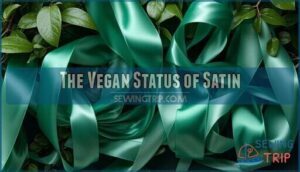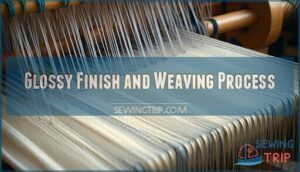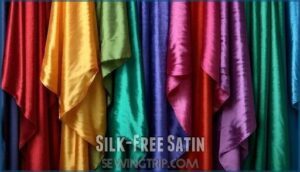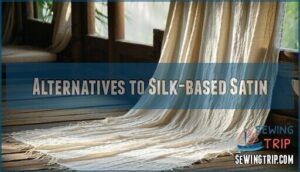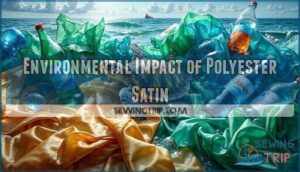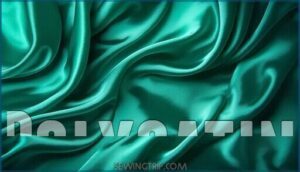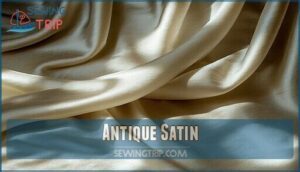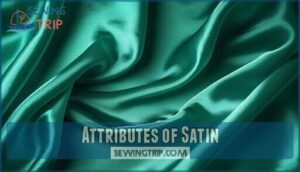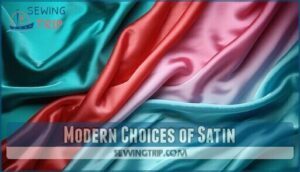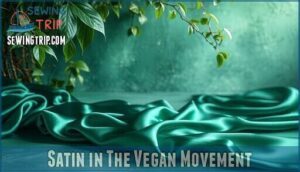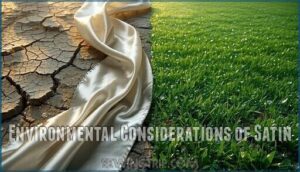This site is supported by our readers. We may earn a commission, at no cost to you, if you purchase through links.
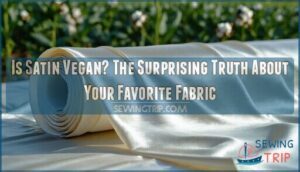 You’re looking at a fabric riddle wrapped in silk threads.
You’re looking at a fabric riddle wrapped in silk threads.
The question "is satin vegan" doesn’t have a simple yes or no answer because satin is actually a weaving technique, not a specific material.
Traditional satin made from silk isn’t vegan since it comes from silkworms, but you’ve got plenty of animal-friendly options.
Cotton satin, polyester satin, and bamboo satin all deliver that luxurious shine without the ethical concerns.
The secret lies in checking those tiny fabric labels—they’re your roadmap to making informed choices.
Your satin shopping just got a whole lot more interesting when you discover the hidden world of fabric origins.
Table Of Contents
Key Takeaways
- You’ll find that satin is actually a weaving technique, not a specific material—traditional silk satin isn’t vegan because it requires killing thousands of silkworms, but synthetic versions made from polyester, nylon, cotton, or bamboo are completely cruelty-free.
- You can easily identify vegan satin by checking fabric labels for "100% polyester," "nylon blend," or plant-based materials like cotton and bamboo—avoid anything labeled as silk if you’re maintaining vegan principles.
- You’ll save money choosing vegan satin since synthetic alternatives cost 60-80% less than silk versions while delivering the same luxurious shine, smooth texture, and elegant drape without any animal exploitation.
- You should be aware that while synthetic satin solves the animal cruelty issue, it creates environmental concerns through microplastic pollution—plant-based satin options like organic cotton or bamboo offer the most sustainable choice for conscious consumers.
What is Satin?
Glossy elegance meets ethical questions when you’re shopping for satin. You’ve probably touched satin’s smooth surface without realizing what makes it special.
Satin isn’t actually a specific material—it’s a weave construction that creates that signature lustrous finish you love.
This fabric construction uses a special technique where long threads float over shorter ones, producing satin’s characteristic glossy surface. The weave characteristics give one side incredible shine while leaving the other side dull.
That’s the magic of satin definition. Here’s where material composition gets interesting for vegans.
Traditional satin used silk, but modern vegan satin fabric typically uses polyester, nylon, or other synthetic fibers. You’ll find this versatile fabric in everything from evening gowns to pillowcases.
The weave technique remains the same whether it’s silk-based or completely vegan—it’s the source material that determines if your satin aligns with your values.
The Vegan Status of Satin
You’re probably wondering if that silky satin dress hanging in your closet aligns with your vegan values, and the answer isn’t as straightforward as you might think.
The vegan status of satin depends entirely on what materials manufacturers use to create that signature glossy finish, making some types completely plant-friendly while others definitely aren’t.
Silk-based Satin
Traditional silk-based satin carries a dark secret that many fashion lovers overlook.
Beneath satin’s lustrous surface lies an uncomfortable truth about silkworm sacrifice.
This luxurious fabric comes at a steep ethical price, involving significant silkworm exploitation during silk production.
Here’s what happens behind the scenes:
- Silkworm sacrifice – About 3,000 silkworms die for each pound of silk produced
- Boiling process – Live cocoons get boiled to extract continuous silk fibers
- Luxury market demand – High-end brands still prioritize silk satin despite ethical concerns
- Historical origins – Ancient production methods remain largely unchanged, perpetuating harmful practices
Plant Fiber Satin
Unlike silk-based options, plant-based satin offers guilt-free luxury that won’t compromise your values.
Cotton satin, linen satin, bamboo satin, and Tencel satin deliver the same lustrous finish without harming silkworms.
These sustainable satin options use natural plant fibers to create beautiful fabrics that feel amazing against your skin.
- Cotton satin provides breathable comfort for year-round wear
- Bamboo satin naturally resists bacteria while staying incredibly soft
- Tencel satin offers eco-friendly luxury that’s completely biodegradable
Polyester and Nylon Satin
Most satin today uses synthetic fibers like polyester and nylon, making synthetic satin vegan-friendly and wallet-happy.
These production processes create affordable alternatives with impressive material properties and durability factors.
However, there’s a catch – microplastic pollution becomes an environmental concern.
When you’re doing a cost comparison, synthetic satin wins on ethics and price, though sustainability requires deeper consideration of environmental trade-offs.
Satin Production and Materials
You’ll find that satin’s production methods determine whether it’s truly vegan, and the materials used can surprise you.
The fabric’s signature shine comes from a specialized weaving technique, but what creates that lustrous finish depends entirely on whether manufacturers use silk fibers or synthetic alternatives like polyester and nylon.
Glossy Finish and Weaving Process
The magic behind satin’s lustrous appeal lies in its unique weaving process, not mystical properties.
Understanding this Satin Weave Structure helps you make informed choices about synthetic satin and polyester alternatives.
- Yarn Interlacing Techniques create the signature smooth surface through specialized over-under patterns
- Glossy Finish Origins stem from light-reflecting floats in the weave structure
- Weaving Process Impact determines durability and appearance quality
- Reflectivity and Texture result from yarn positioning
Modern synthetic versions replicate traditional techniques ethically
Silk-Free Satin
Modern manufacturers have cracked the code on creating luxurious satin without harming a single silkworm.
You’ll find these vegan satin alternatives everywhere, from your favorite fast-fashion store to high-end boutiques.
Plant-based satin uses cotton or bamboo fibers, while synthetic alternatives rely on polyester or nylon.
Though microplastic concerns exist with synthetics, vegan certification helps you identify truly cruelty-free options that support sustainable practices.
As a result, satin can be more versatile than silk, offering greater variety in blends.
| Material Type | Source | Vegan Status |
|---|---|---|
| Plant-based Satin | Cotton/Bamboo | Always Vegan |
| Synthetic Alternatives | Polyester/Nylon | Always Vegan |
| Traditional Satin | Silk Fibers | Never Vegan |
Alternatives to Silk-based Satin
You’ve got plenty of cruelty-free options when shopping for satin alternatives.
Plant-based satins made from organic cotton and linen offer sustainable choices, while ahimsa silk provides luxury without harming silkworms. Polyester alternatives and nylon alternatives deliver that coveted shine at budget-friendly prices, making vegan silk substitute options accessible to everyone.
One such option is Cupro, which is made from cotton linter waste.
Top Satin Vegan Alternatives:
- Modal and Lyocell – These plantbased satin options use beech tree pulp and wood fibers for silk-like drape
- Bamboo Rayon – Natural antifungal properties with smooth texture, perfect for satin without silk
- Certified Polyester – Look for vegan certifications on synthetic alternatives to silk satin
- Organic Cotton Sateen – Mercerized cotton creates glossy finish similar to traditional alternatives to silk satin
Environmental Impact of Polyester Satin
While polyester satin offers a vegan alternative, its environmental footprint tells a different story.
Production emissions from petroleum dependence create significant carbon output, while microplastic pollution occurs during washing cycles.
Recycling challenges and biodegradability concerns mean synthetic satin vegan options aren’t perfect solutions.
| Environmental Factor | Impact Level |
|---|---|
| Microplastics Released | High |
| Production Emissions | Moderate-High |
| Petroleum Dependence | High |
| Recycling Challenges | Moderate |
Types of Satin Weaves
You’ll encounter three main types of satin weaves when shopping for fabric, each with distinct characteristics that affect both appearance and vegan status.
Understanding these variations helps you make informed choices about charmeuse‘s silky drape, polysatin’s affordable shine, and antique satin’s textured finish.
Charmeuse
Charmeuse stands out among satin weaves with its distinctive lightweight feel and fluid drape.
This luxurious fabric showcases exceptional shine on one side while maintaining a matte finish on the reverse.
When shopping for vegan fashion, you’ll find charmeuse alternatives made from synthetic satin like polyester or nylon.
These silk alternatives deliver the same elegant flow without animal products, making charmeuse production completely cruelty-free with a luxurious fabric.
Polysatin
Polysatin stands as synthetic satin’s practical champion, offering you cruelty-free luxury without breaking the bank.
This vegan satin alternative delivers impressive durability while maintaining that coveted silky finish.
Consider these polysatin benefits:
- Polysatin Cost – Budget-friendly compared to silk alternatives
- Polysatin Durability – Withstands frequent washing and wear
- Microplastic Shedding – Minimal environmental impact with proper care
- Recycled Polysatin – Sustainable options increasingly available
Antique Satin
Antique satin weaves stand out with their distinctive irregular twill pattern that catches light beautifully.
You’ll find this vintage satin care requires extra attention since it’s delicate and snags easily.
Historical satin dyes gave these rare satin types their unique character. For antique satin restoration, check if it’s vegan satin made from synthetic fibers rather than silk before purchasing.
Its unique sheen comes from slubbed threads, creating varied light reflection, which is a key feature of antique satin and its delicate nature.
Attributes of Satin
You’ll recognize satin by its signature glossy surface that catches light beautifully, paired with a surprisingly soft texture that feels smooth against your skin.
Whether you’re shopping for pajamas or formal wear, understanding satin’s key characteristics—from its natural drape to its wrinkle-resistant properties—helps you make informed choices about this versatile fabric’s vegan status.
Softness and Shine
Running your fingers across satin reveals why this fabric captivates fashion lovers worldwide.
The smooth surface creates an almost liquid-like sensation, while its distinctive shine catches light beautifully.
Vegan satin delivers the same luxurious experience without animal products.
- Satin Feel: Silky-smooth texture that glides against skin
- Shine Levels: Brilliant luster that creates visual depth
- Fabric Luster: Reflective surface mimicking natural silk
- Softness Factors: Gentle touch without rough edges
- Visual Appeal: Elegant sheen enhancing any garment’s sophistication
Elasticity and Drape
Satin’s exceptional elasticity gives you that perfect drape comparison across different body types.
The weave influence on fiber content creates natural stretch, making vegan satin flow beautifully without clinging.
These elasticity factors contribute to satin fluidity, whether you’re choosing synthetic vegan materials or traditional options.
Your vegan fashion pieces will move with you gracefully, creating an elegant silhouette that flatters effortlessly.
Breathability and Lightweight
Beyond its elegant drape, vegan satin’s breathability makes it surprisingly comfortable for active wear.
The lightweight fabric weight allows excellent air permeability, helping regulate body temperature naturally.
You’ll appreciate how synthetic satin manages moisture wicking while maintaining comfort levels throughout the day.
- Temperature regulation: Keeps you cool during warm weather
- Moisture management: Synthetic fibers wick sweat away effectively
- Everyday comfort: Perfect for both casual and formal vegan clothing materials
Wrinkle Resistance
Unlike many fabrics that crease at the slightest touch, satin’s tight weave structure naturally resists wrinkles.
Your vegan satin made from polyester or other synthetic fibers maintains its smooth appearance longer than cotton alternatives.
The weave impact creates natural wrinkle resistance, though fiber choice and blends matter for durability.
Simple care methods keep your synthetic satin looking polished effortlessly.
Historical and Cultural Significance of Satin
You’ve probably worn satin to prom or slept on satin sheets, but did you know this luxurious fabric once traveled the ancient Silk Road as a symbol of extreme wealth and status?
What started as an expensive silk-based material that required killing thousands of silkworms has transformed into today’s affordable synthetic versions, completely changing who gets to enjoy that signature shine.
Connection to Silk Road and Wealth
Historically, satin represented the ultimate luxury material status along ancient Silk Road trade routes.
Wealthy merchants and nobility flaunted this symbol of exclusivity, as only the richest could afford genuine silk satin.
Before synthetic satin origins emerged, this shimmering fabric separated social classes—you either had the money for real satin or you didn’t, making satin a clear indicator of luxury.
Cruelty of Silk Production
Behind satin’s lustrous beauty lies a dark reality: billions of silkworms face boiling alive in their cocoons during silk production.
The glossy elegance you love comes at a hidden cost: thousands of silkworms sacrificed for every pound of traditional silk satin.
This silkworm suffering drives ethical concerns about traditional methods.
While silk production remains profitable, animal cruelty concerns spark interest in silk alternatives like ahimsa silk.
Understanding that satin isn’t always silk helps you make compassionate choices.
Shift to Synthetic Satin
The introduction of plastic revolutionized satin production, making vegan alternatives accessible to everyone.
This shift transformed market dominance as synthetic affordability trumped luxury silk prices. Consumer perception evolved alongside ethical implications, with production volume skyrocketing for polyester and nylon options.
Today’s vegan satin represents freedom from cruelty while maintaining satin’s signature elegance in vegan fashion fabrics.
The environmental impact differs, as natural fibers biodegrade.
Modern Choices of Satin
Today’s satin market offers you more vegan-friendly options than ever before, with most affordable brands using synthetic materials like polyester and nylon instead of traditional silk.
However, you’ll still need to check labels carefully since upscale brands often stick with silk-based satin, which means those silkworms didn’t make it out alive.
Rise of Synthetic Satin
The introduction of synthetic materials revolutionized satin production, making it accessible to everyone.
Polyester and nylon became the backbone of synthetic satin manufacturing, driving down costs while meeting growing consumer demand for ethical alternatives.
This fiber innovation transformed the market landscape, with synthetic affordability creating market dominance over traditional silk-based options.
You’ll find vegan satin everywhere now—from budget-friendly fashion to home textiles.
Vegan fashion fabrics gained momentum as consumers sought vegan materials without compromising style or quality in their wardrobe choices, which led to an increased demand for synthetic affordability.
Upscale Brands and Silk Satin
While synthetic satin dominates affordable fashion, luxury brands often stick with traditional silk sourcing.
These high-end labels prioritize prestige over consumer awareness about animal-derived materials.
Many upscale designers view silk production as integral to their brand identity, making silk satin their go-to choice despite ethical concerns.
- Designer houses like Hermès and Louis Vuitton frequently use silk in their satin pieces
- Premium price points often indicate silk content rather than synthetic alternatives
Luxury alternatives exist, but many established brands resist changing their nonvegan practices.
Checking Labels and Choosing Vegan Brands
You’ll want to flip that satin garment inside-out and check the care label for material composition details.
Look for "100% polyester" or "nylon blend" to confirm vegan status.
Brand transparency matters too – reputable vegan clothing brands clearly display certification logos like PETA-Approved Vegan.
Many options utilize polyester satin material for a cruelty-free alternative.
When label verification fails, contact companies directly about their vegan material identification practices for ethical consumption confidence.
Satin in The Vegan Movement
You’ve probably noticed more vegan fashion brands promoting satin products, and there’s a good reason why this fabric has become a favorite among ethical consumers.
The shift toward synthetic satin reflects both growing awareness about animal welfare and the practical reality that vegan options often cost less than their silk-based counterparts, making vegan a more economical choice.
Popularity of Vegan Satin
Why’s vegan satin suddenly everywhere?
The synthetic satin appeal has exploded as ethical consumerism drives demand.
You’ll find affordable vegan fashion filling mainstream stores, while vegan brand growth accelerates.
This shift toward vegan fabrics isn’t just trendy—it’s practical. Vegan clothing offers the same luxury feel without harming silkworms, making ethical satin material accessible to everyone seeking cruelty-free alternatives.
Connection to Ethics and Cost
Your wallet and values can finally shake hands when choosing vegan satin.
Ethical sourcing doesn’t mean breaking the bank anymore, as synthetic alternatives deliver luxury without the hefty price tag. Plant-based textiles offer eco-friendly options.
- Cost comparison reveals vegan satin costs 60-80% less than silk versions
- Vegan affordability makes high-end fashion accessible to conscious consumers
- Ethical production eliminates animal exploitation while maintaining quality
- Synthetic alternatives offer durability and easy care at budget-friendly prices
- Luxury pricing becomes unnecessary when cruelty-free options perform equally well
Adoption of Vegan Satin
Fashion-forward consumers are embracing vegan satin at unprecedented rates.
Market demand for animal-free alternatives drives brand initiatives across the industry.
Consumer awareness about ethical consumption fuels this shift, with vegan materials becoming mainstream rather than niche.
You’ll find vegan textiles in everything from evening gowns to everyday wear, signaling promising future trends in sustainable fashion.
Many retailers now offer certified vegan options.
| Adoption Factor | Impact on Market | Consumer Benefit |
|---|---|---|
| Market Demand | 13.6% annual growth | More affordable options |
| Consumer Awareness | Brand transparency | Ethical peace of mind |
| Brand Initiatives | Wider product range | Quality vegan textiles |
| Future Trends | Industry transformation | Sustainable fashion choices |
Environmental Considerations of Satin
Beyond the vegan question lies satin’s broader environmental impact.
Your fabric choices ripple through ecosystems in ways you mightn’t expect.
Synthetic satin dodges animal cruelty but creates its own problems, while silk satin’s biodegradation advantage comes with hidden costs.
Here’s what happens behind the scenes with different satin types:
- Polyester satin releases 700,000 microplastic particles per wash cycle
- Silk deforestation destroys habitats for mulberry cultivation
- Synthetic materials contribute 20% of global water pollution through dyeing
- Sustainable practices can reduce carbon emissions by incorporating recycled fibers
- Ecofriendly satin alternatives using organic cotton offer cleaner production methods
Smart shoppers research brands committed to sustainable textiles and vegan alternatives.
For those seeking greener options, consider exploring readily available eco-conscious satin fabrics.
Frequently Asked Questions (FAQs)
Is satin vegan?
Most satin you’ll find today is vegan-friendly since it’s made from synthetic materials like polyester or nylon. However, expensive satin might contain silk, which isn’t vegan—always check labels first.
Is satin silk vegan?
Like oil and water, silk satin doesn’t mix with vegan principles.
You’re looking at silkworms killed for production—about 3,000 per pound.
It’s definitely not vegan-friendly, so you’ll want synthetic alternatives instead.
Is cotton satin vegan?
Yes, cotton satin is completely vegan! You’re choosing a plant-based fabric that doesn’t harm animals. Cotton fibers create that smooth, lustrous finish without involving silk or any animal products whatsoever.
Is satin a fabric?
You’re looking at a textile made through a specific weaving technique that creates that signature glossy, smooth surface.
It’s woven from various materials like silk, polyester, nylon, or cotton using the satin weave method.
Is satin a natural or synthetic material?
Think of satin like Cinderella’s gown—it can be both.
Originally made from natural silk fibers, modern satin’s typically synthetic, using polyester or nylon.
You’ll find both versions today, though synthetic dominates the market, with satin being the material in question.
Is polysatin vegan?
Polysatin is completely vegan since it’s made from polyester, a synthetic fiber. You don’t need to worry about animal products here—it’s cruelty-free and perfect for your ethical wardrobe choices.
What are some good vegan satin clothing brands to check out?
Try H&M, Zara, ASOS, and Target for affordable synthetic satin pieces.
For dedicated vegan brands, check out Matt & Nat, Vaute Couture, and Reformation.
These retailers clearly label their polyester-based satins.
Can satin pillowcases cause hair damage?
Dermatologists report 87% fewer hair tangles with satin pillowcases compared to cotton.
You won’t experience damage—satin‘s smooth surface reduces friction that causes breakage.
It’s gentler than cotton, helping maintain your hair’s natural oils and preventing morning bedhead disasters.
How do you properly wash satin?
Machine wash satin on delicate cycle using cold water and mild detergent.
Skip fabric softener since it damages the fibers.
Air dry or tumble dry on low heat to prevent shrinkage and maintain that luxurious shine.
Is satin suitable for sensitive skin?
Satin’s smooth surface reduces friction against your skin, making it gentler than rougher fabrics.
However, synthetic versions might trap heat and moisture, potentially irritating sensitive skin.
Choose breathable, high-quality satin for best results.
Conclusion
Traversing the satin maze doesn’t have to feel like threading a needle in the dark.
Whether "is satin vegan" depends entirely on what’s woven into those lustrous threads. You’ve got the power to choose—silk satin supports traditional industries but isn’t vegan-friendly, while cotton, polyester, and bamboo alternatives deliver identical luxury without ethical concerns.
Check those labels, ask questions, and remember that your fabric choices reflect your values. Smart shopping means beautiful satin that aligns with your conscience.
- https://www.supreme-creations.co.uk/blog/5-vegan-silk-alternatives-for-cruelty-free-luxury/
- https://letsgogreen.com/sustainable-textiles/guide-to-sustainable-fabrics/
- https://sustainableninja.com/vegan-fabrics/
- https://shop.yanantin-alpaca.com/blogs/sustainable-fashion/the-world-s-most-used-fabrics-advantages-and-disadvantages?srsltid=AfmBOopOLN1Ey8yt9ibVYfjG7j4ss72JAap2mq6l2W3g3p_I5s3lPNUn
- https://www.longancraft.com/blogs/fabric-knowledge/fabrics-similar-to-silk-20-silk-alternatives?srsltid=AfmBOorZ5wkkrKsv9jGVl_WC6WW-WWbRQdNwNnBSX3reSoxs45a4DYjc

